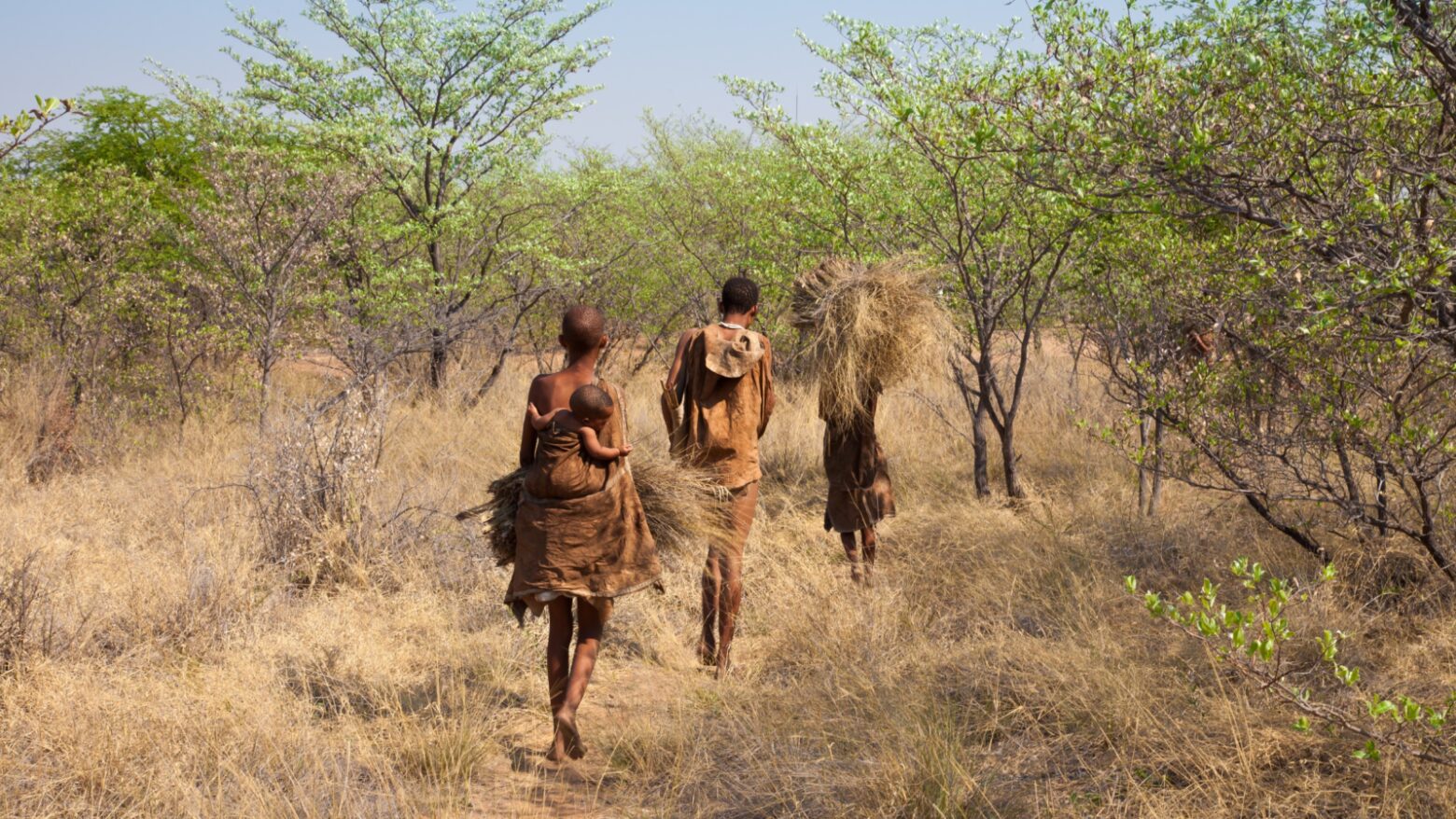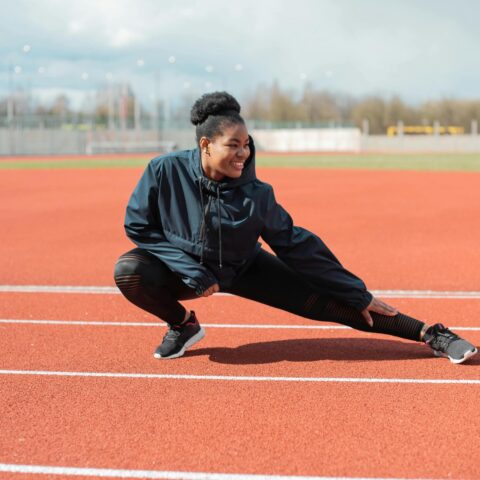The Exercise Habits of Hunter-Gatherers

Don’t let the title fool you, hunter-gatherers did not exercise—at least, not in the modern sense of the word. Nearly all our hunter-gatherer ancestors’ movements were in response to the physical demands of their lives: finding food and water, escaping from dangers, building shelter, and caring for children, to name a few. Except for the very young and old, everyone was required to do physical labor on a regular basis in order to survive. [1]
In all aspects of hunter-gatherer life, there was a reason for the activity. Energy input (food) was directly related to energy expenditure (exercise). If they wanted to eat, they had to work for it. By contrast, a modern human’s equivalent in energy expenditure amounts to moving groceries from the car to the house.
Therefore, the daily activity associated with gathering what we need to eat doesn’t provide the activity we require for optimal health. So, can we “exercise” like a hunter-gatherer? In order to answer this, we must first look at the history of “exercise.”
A brief history of exercise
In the Stone Age, some 2.3 million years ago, moderate to difficult aerobic activity, accompanied by strength movements, characterized most hunter-gatherers’ days. Hunter-gatherers would alternate between hard days of exertion and easy days filled with more rest. This was important because regular high-intensity exercise increased their risk of injury and illness, which could impede their ability to hunt and gather food. Worse, a serious injury could mean devastating consequences in the absence of modern medical practices.
It wasn’t until the Agricultural Revolution 10,000 years ago that man’s physical activity changed. While farm work was demanding, the complexity of movements diminished: daily activities became more repetitive and required a more limited range of motion. Growing food and raising cattle were vastly different from the running, jumping, crawling, climbing, and balancing that the hunter-gatherer lifestyle required.
Fast forward to today, the digital age, and technology has all but eliminated the need for daily physical exercise in the past 2-3 generations. The result has been the obesity epidemic and spike in rates of chronic disease. Our sedentary lifestyle goes against the intrinsic requirements of our genome, which was designed for the hunter-gatherer lifestyle.
Hunter-gatherer’s exercise habits
Kim Hill, Ph.D., an anthropologist at Arizona State University, has spent the last 30 years living and studying the Achè hunter-gatherers of Paraguay and the Hiwi of southwestern Venezuela. He is one of the few people who has experienced what it is like to “run with the hunt”. He observed that, in a single day, the Achè traveled an average of 10 to 12 kilometers at a pace of 1.5 – 3 km/hour, with the occasional 20-30-second sprint. (A swift pace given the thick vegetation of their environment.) This lasted for seven to nine hours per day, with little to no rest. The only days they refrained from hunting were when it rained, which averaged one to two days per week in the rainforest. [2], [3]
While women did not participate in the hunt, they still engaged in strenuous aerobic work. Women foraged for food, water, and wood every two or three days. They spent many hours walking to food sources, then digging, climbing, and hauling heavy loads back to camp, often while carrying children. [4]
Both men and women also built tools and shelters, butchered and prepared meals, visited other villages, sometimes 80-100 kilometers away, and danced several nights a week.
Below is a table of the calories that hunter-gatherers burned from each activity, reemphasizing the importance of their food intake:
Table 1. Daily calories burned during typical hunter-gatherer activity. Calories burned (kilocalories per hour) is based on a 176-pound man or 132-pound women.
| Activity | Calories Burned |
|---|---|
| Carrying logs | 893 |
| Running (cross-country) | 782 |
| Carrying meat (20kg) back to camp | 706 |
| Carrying a young child | 672 |
| Hunting, stalking prey (carrying bows and spears) | 619 |
| Digging (in a field) | 605 |
| Dancing (ceremonial) | 494 |
| Stacking firewood | 422 |
| Butchering large animals | 408 |
| Walking (normal pace in fields and hills) | 394 |
| Gathering plant foods | 346 |
| Archery | 312 |
| Scraping a hide | 302 |
| Shelter construction | 250 |
| Flint knapping | 216 |
Hunter-gatherers were the original cross trainers. They had well-rounded strength and endurance in order to perform a wide variety of physical tasks, making them fitter than the average modern human. That said, it’s likely no hunter-gatherer could have outpaced an Olympic endurance athlete. Why? Their focus was on ample calories, not peak physical performance.
The liability of injury and illness was not the only reason they avoided high-intensity activities. Without daily consumption of high-glycemic-load carbohydrates, commonly obtained from non-Paleo foods such as grains, it was much harder to perform the sort of maximal efforts seen in modern athletes. It was their high fat and protein diet that allowed them to do aerobic work at moderate intensity for extended periods of time, almost every day.
How to duplicate their fitness regime
All in all, hunter-gatherers were still more physically fit than the average individual today. The key to their health was that they were always moving. Research suggests 45 to 90 minutes of cumulative daily physical exercise is necessary to attain and sustain an ideal body weight. The following guidelines come from The Paleo Diet for Athletes, written by Dr. Loren Cordain and exercise physiologist Joe Friel. [5]
- Mix endurance with strength and flexibility: While the concept of cross-training was only enlisted by coaches and varsity athletes 50 years ago, it’s effectiveness can be traced back millions of years to our hunter-gatherer ancestors. It wasn’t enough to just be able to chase after their prey for hours at a time, they had to be able to carry it back the distance they traveled too.
- Interval training: You may have heard of this strategy before: sixty seconds on, sixty seconds off. Like hunter-gatherers’ periodic sprints, interval training is rotating short stints of intense exercise with rest and recovery periods. It has been shown to produce better weight loss, superior glucose control, and greater fitness gains than equivalent or longer amounts of continuous lower intensity activity.
- Incorporate rest into your workout schedule: Alternating days of intense exercise with less demanding ones lowers your risk of injury, but research has shown it also produces better fitness. So, only perform strenuous interval workouts twice a week at most and spend the rest of the days performing moderate or easy routines and resting.
- Exercise outdoors: There is evidence to support that exercising outside may provide added health benefits to your workout. This is because the sun provides longer lasting levels of Vitamin D than oral digestion, which decreases risks of cardiovascular disease. Plus, the outdoors is known to reduce emotional stress and improve mood. So, go for a hour walk outside; bonus points if it’s in a natural environment full of grass and trees.
Don’t feel you have to incorporate all these tips into your routine though. Hunter-gatherers have proven that exercise doesn’t have to equate to structured workouts at the gym or studio—walking, carrying, and even hanging can be the right first steps to exercising like our Paleolithic ancestors.
References
[1] L. Cordain and J. Friel, The Paleo Diet for Athletes: The Ancient Nutritional Formula for Peak Athletic Performance, Rev. New York: Rodale, 2012.
[2] R. Walker, K. Hill, H. Kaplan, and G. McMillan, “Age-dependency in hunting ability among the Ache of Eastern Paraguay,” J Hum Evol, vol. 42, no. 6, pp. 639–657, 2002, doi: 10.1006/jhev.2001.0541.
[3] U. King and C. Furgal, “Is Hunting Still Healthy? Understanding the Interrelationships between Indigenous Participation in Land-Based Practices and Human-Environmental Health,” Int J Environ Res Pu, vol. 11, no. 6, pp. 5751–5782, 2014, doi: 10.3390/ijerph110605751.
[4] J. Koster et al., “The life history of human foraging: Cross-cultural and individual variation,” Sci Adv, vol. 6, no. 26, p. eaax9070, 2020, doi: 10.1126/sciadv.aax9070.
[5] L. Cordain and J. Friel, “The Paleolithic Athlete: The Original Cross-Trainer.” The Paleo Diet for Athletes: the Ancient Nutritional Formula for Peak Athletic Performance, Rodale, 2012, pp. 179–190
Emily Rumsey
Emily Rumsey joined The Paleo Diet® in the summer of 2020 and then was promoted to Website Manager. She graduated from the University of Colorado, Boulder with a BA in Journalism.
More About The Author




